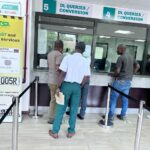In Kenya’s bustling transport sector, where matatus zoom through Nairobi’s traffic and boda bodas weave across rural roads, vehicle ownership isn’t just about keys and wheels—it’s a legal lifeline. For many Kenyans, securing a car or motorcycle often involves financing, turning logbooks into shared assets between owners and lenders. But what happens when you’ve cleared that loan? That’s where the removal of ownership discharge comes in, a crucial step to reclaim full control of your vehicle. As of August 2025, with vehicle registrations hitting record highs amid economic recovery, understanding how to apply for discharge on the NTSA portal has never been more essential. This comprehensive guide dives into the NTSA vehicle services, unpacking the discharge process in Kenya, from requirements to potential pitfalls, ensuring you’re equipped to navigate the eCitizen account smoothly.
Whether you’re a first-time car owner in Mombasa or a fleet manager in Eldoret, the National Transport and Safety Authority (NTSA) portal streamlines what used to be a paperwork nightmare. Gone are the days of endless queues at government offices; now, it’s all digital. Yet, with over 5 million vehicles on Kenyan roads, mishaps in the removal of ownership discharge can lead to delays, fines, or even legal headaches. We’ll cover everything you need to know about applying for discharge NTSA-style, drawing from official guidelines and real-world insights to make the process relatable and actionable.
Understanding Removal of Ownership Discharge in Kenya
Removal of ownership discharge, often simply called “discharge of charge,” is a formal procedure to remove a financier’s or lender’s claim from your vehicle’s logbook. In Kenyan transport lingo, this happens when a vehicle has been used as collateral for a loan—think logbook loans that have surged in popularity since the early 2020s. Once the debt is settled, the lender issues a discharge letter, and you apply via the NTSA portal to update the records, effectively “discharging” their co-ownership.
This isn’t just bureaucratic red tape; it’s rooted in Kenya’s Traffic Act, which mandates clear ownership to prevent disputes. Imagine buying a second-hand Toyota Vitz only to discover a hidden bank lien—discharge ensures transparency. In 2025, with digital lending platforms booming, NTSA reports a 15% uptick in such applications, reflecting the growing vehicle financing market. For context, logbook loans allow borrowers to keep driving while using the vehicle as security, but the logbook lists the lender as a co-owner until discharge.
Why does this matter in Kenya? Our roads are lifelines for commerce—from tea transporters in Kericho to delivery riders in Kisumu. Unresolved charges can block sales, insurance claims, or even NTSA inspections. Plus, with the government’s push for electric vehicles and sustainable transport, clear ownership is key for incentives like tax rebates.
Why You Might Need to Apply for Discharge on NTSA Portal
Picture this: You’ve hustled through monthly installments on your logbook loan, and finally, the balance hits zero. Congratulations—but your work isn’t done. Applying for removal of ownership discharge is the final hurdle to sole ownership. Common scenarios include:
- Loan Repayment Completion: Most Kenyans opt for logbook loans from institutions like Mogo or NCBA, where the lender holds a charge until full payment. Discharge releases this hold, updating the logbook.
- Vehicle Sale or Transfer: Selling a charged vehicle? Buyers demand a clean logbook. Without discharge, transfers stall, as seen in rising complaints to NTSA helplines.
- Refinancing or Upgrading: Switching lenders or trading up requires discharging old charges to avoid overlapping claims.
- Legal Compliance: Under NTSA rules, unresolved charges can lead to vehicle impoundment during routine checks, especially on highways like Thika Road.
In 2025, new lending regulations emphasize borrower protections, making timely discharge even more critical to avoid penalties. For small business owners relying on vehicles for income—say, a mama mboga with a pickup truck—this process safeguards livelihoods against repossession risks.
Key Requirements for Removal of Ownership Discharge
Before diving into the NTSA portal, gather your ducks in a row. Official NTSA guidelines stress complete documentation to avoid rejections. Here’s what you’ll need:
- Discharge Letter from Financier: This official release confirms loan clearance. It must include vehicle details, your info, and the lender’s stamp. For 2025, digital versions are accepted if verifiable.
- Original Logbook: Scan the current logbook showing the charge. NTSA insists on high-quality PDFs—no blurry photos from your smartphone.
- Vehicle Registration Number: Essential for searches on the portal.
- eCitizen Account: If you don’t have one, create it at ecitizen.go.ke. It’s your gateway to all NTSA vehicle services.
- ID Documents: Your national ID or passport for verification.
- Payment Method: Ready your M-Pesa or card for fees.
Additional tips: If the vehicle is jointly owned, all parties must consent. For imported cars, ensure KEBS roadworthiness certificates are up to date. Pro tip: Combine the logbook and discharge letter into one PDF file, as required—tools like Adobe Acrobat or free online mergers work wonders.
Failing to meet these can lead to application bounces, adding weeks to the timeline. In Kenyan contexts, where cybercafes in places like Nakuru handle these for folks without internet, double-check uploads for accuracy.
Step-by-Step Guide: How to Apply for Discharge on NTSA Portal
The beauty of the NTSA portal lies in its user-friendliness, integrated with eCitizen for seamless access. As of 2025, the process remains straightforward, with minor UI tweaks for mobile optimization. Follow these steps for a hassle-free application:
- Log In to Your eCitizen Account: Head to ecitizen.go.ke and sign in. If new, register using your ID and phone number. This portal handles everything from NTSA vehicle services to business permits.
- Select NTSA Service Portal (New): Once logged in, navigate to the NTSA section. Click on the “New” portal option—it’s the updated version with faster loading.
- Go to Switch Account and Click on Discharge: Under the vehicle management menu, find “Switch Account” or similar (labels might vary slightly). Select “Discharge” to initiate removal of ownership discharge.
- Input Vehicle Registration Number and Click Search: Enter your plate number (e.g., KAB 123C) accurately. The system pulls up your vehicle details—verify everything matches your logbook.
- Attach Logbook and Discharge Letter as One PDF: Upload the combined file. Ensure it’s under the size limit (usually 5MB) and in PDF format only. NTSA rejects other types like JPEGs.
- Select Preferred Counter of Collection and Authorized Person: Choose where to pick up the updated logbook, like NTSA offices in Nairobi or regional hubs in Kisii. Nominate yourself or a trusted proxy with ID.
- Scroll Down, Tick the Declaration Box, Then Click Preview: Review all details for errors. Ticking confirms accuracy and compliance with Kenyan laws.
- Submit to Pay for Removal of Ownership and Click Complete: Proceed to payment. Once done, you’ll get a confirmation email or SMS.
This mirrors NTSA’s official process, shared via their channels. Expect an application reference number for tracking. In practice, Kenyans in rural areas like Kitui often use agents, but doing it yourself saves cash.
Costs and Processing Timeline for NTSA Discharge
Budgeting is key in Kenya’s economy, where every shilling counts. The standard charge for removal of ownership discharge is Ksh 1,175, covering admin fees—no hidden extras unless you opt for express services. Break it down:
- Application Fee: Ksh 1,000
- Convenience Fee: Ksh 175 (for portal processing)
Payments are via eCitizen’s secure gateway, accepting M-Pesa, Airtel Money, or cards. No cash at counters anymore, reducing corruption risks.
Timeline? Officially, 3 working days from submission to approval. In 2025, NTSA’s digital upgrades have cut delays, but peak periods (end of financial year) might stretch it to a week. Collect your new logbook at the chosen counter—bring ID and the reference.
Compared to vehicle transfers (Ksh 2,000+), discharge is affordable, encouraging prompt applications amid rising fuel costs and maintenance burdens.
Common Challenges in the Discharge Process and Solutions
No process is flawless, especially in Kenya’s tech landscape where network glitches hit hard in areas like Garissa. NTSA highlights several pitfalls in ownership-related applications. Here’s how to dodge them:
- Document Upload Errors: Blurry scans or separate files lead to rejections. Solution: Use a scanner app and merge PDFs beforehand.
- Incorrect Vehicle Details: Mismatched reg numbers cause system flags. Double-check against your logbook.
- Payment Failures: eCitizen glitches during peak hours. Try off-peak or switch payment methods.
- Delayed Discharge Letters: Lenders sometimes drag feet. Follow up via email or their apps—new 2025 rules mandate 7-day issuance.
- Joint Ownership Issues: If multiple owners, all must approve. Get consents in writing.
Real story: A Nairobi driver shared on social platforms how a wrong PDF format delayed his discharge by two weeks, costing him a potential sale. NTSA advises calling their helpline (0709 932 300) for guidance—it’s toll-free and responsive.
Tips for a Smooth NTSA Vehicle Discharge Experience
To make your application breeze through, heed these Kenyan-centric tips:
- Prepare Early: Request the discharge letter 7-10 days post-repayment, aligning with lender timelines.
- Go Digital-Savvy: Use a stable internet connection; public Wi-Fi in cafes can be unreliable.
- Track Progress: Log back into the NTSA portal daily to monitor status.
- Seek Help if Needed: For tech-challenged users, NTSA partners with huduma centers nationwide.
- Stay Updated: Follow NTSA on X or their site for 2025 alerts, like system maintenance.
In vehicle financing hubs like Thika, where logbook loans fund businesses, these steps prevent downtime. Remember, a discharged logbook boosts your vehicle’s resale value by 10-20%.
Related NTSA Services and Broader Kenyan Transport Context
Discharge doesn’t exist in isolation. Explore other NTSA vehicle services on the portal:
- Ownership Transfer: For selling vehicles, similar process but with buyer involvement.
- Logbook Replacement: If lost, apply online for Ksh 2,500.
- Vehicle Inspection: Mandatory annually, linking to discharge for compliance.
In Kenya’s transport evolution, 2025 sees NTSA pushing for green initiatives, like EV registrations with waived duties. Clear ownership via discharge enables access to these perks. With road accidents down 5% thanks to NTSA campaigns, proper documentation plays a role in safety too.
Frequently Asked Questions on Removal of Ownership Discharge
What if my lender refuses the discharge letter? Escalate to the Central Bank of Kenya; regulations protect borrowers.
Can I apply offline? No, it’s fully digital since 2023, but huduma centers assist.
How long does the new logbook last? It’s permanent until the next change.
Is there a grace period post-loan? Lenders must discharge within 14 days of full payment.
What about imported vehicles? Same process, but include import docs.
These queries flood NTSA inboxes, reflecting user intent in searches for “apply for discharge NTSA.”
Navigating the removal of ownership discharge on the NTSA portal might seem daunting, but it’s a gateway to freedom in Kenya’s dynamic transport world. From the streets of Nyeri to the ports of Mombasa, clear logbooks mean peace of mind and economic mobility. By following this guide—gathering docs, mastering the steps, and sidestepping common errors—you’ll join thousands who’ve successfully reclaimed their rides in 2025.
Remember, NTSA’s digital shift is about efficiency, not exclusion. If issues arise, their support is a call away. Stay proactive, keep your eCitizen account active, and drive on with confidence. For the latest on NTSA vehicle services, bookmark ntsa.go.ke—your road to seamless ownership starts here.





